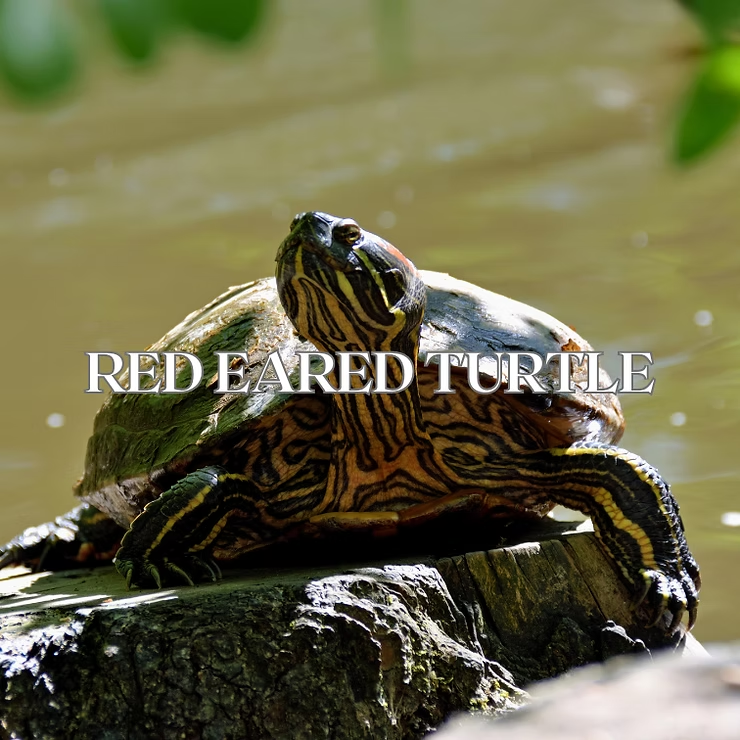Red Eared Turtle: An Adaptable and Fascinating Reptile
The Red Eared Turtle is one of the most recognizable freshwater turtles, known for the bright red markings on the sides of its head. Native to North America but now found across the world, this species has adapted to a wide variety of environments. Its distinctive appearance, versatile diet, and unique behaviors have made it a subject of interest for both scientists and reptile enthusiasts.
Habitat and Behavior
Natural Habitat
Red Eared Turtles thrive in freshwater habitats such as ponds, lakes, rivers, and reservoirs. They prefer environments with calm waters, abundant aquatic vegetation, and basking spots like logs or rocks. These turtles are diurnal, meaning they are most active during the day, spending hours basking in the sun to regulate body temperature.
Preferred Environment
For optimal health, Red Eared Turtles require water temperatures between 75–85°F and a pH range of 6.5–7.5. In captivity, they need both a basking platform and access to UVB light to maintain proper shell development. Their ability to adapt to various water conditions has allowed them to spread widely, even in man-made habitats such as canals and reservoirs.
Territorial Nature
Despite their calm appearance, Red Eared Turtles can be territorial, particularly males. They defend their preferred space with aggressive behaviors such as hissing, biting, and head-butting. Providing ample room and resources is essential to reducing conflict when keeping multiple turtles together.
Physical Characteristics
Shell
The shell is the most striking feature of the Red Eared Turtle, consisting of the carapace (upper shell) and plastron (lower shell). Made of keratin, it offers protection against predators and helps regulate body temperature. Growth rings on the shell can also provide insight into the turtle’s age.
Head and Neck
The triangular head, long flexible neck, and sharp beak give this turtle both defensive and hunting advantages. The red streaks near the ears are its most defining characteristic, setting it apart from other freshwater species.
Limbs and Feet
- Webbed limbs aid in swift swimming
- Strong claws assist in digging nests
- Ability to retract limbs into the shell for defense
Diet and Feeding Habits
Red Eared Turtles are opportunistic omnivores. While they enjoy insects, worms, and small fish, they also consume aquatic plants and algae. In the wild, they scavenge freely and adapt to available food sources. Their strong jaws allow them to tear through prey and vegetation alike, while their sharp sense of smell helps locate food efficiently.
Reproduction and Life Cycle
Mating Rituals
During courtship, males perform displays such as claw fluttering and head bobbing to attract females. Once mating occurs, the female searches for sandy or soft soil near water to build a nest.
Nesting and Hatching
Females typically lay 10–30 eggs in carefully dug nests. After about 60–80 days, hatchlings emerge and instinctively head toward water. This early stage is perilous, with many falling prey to predators before reaching safety.
Growth and Development
Hatchlings start small, about the size of a coin, with soft shells that harden over time. As they grow, their diet expands, and they gradually develop the strength and resilience of adults. Sexual maturity is usually reached after several years, marking the continuation of the cycle.
Frequently Asked Questions
- Where are Red Eared Turtles found? They are native to North America but can be found in freshwater habitats worldwide.
- What environment do they prefer? Warm freshwater areas with basking spots and aquatic vegetation.
- Are they territorial? Yes, especially males who may defend their territory aggressively.
- What is their shell like? A hard keratin structure that protects and regulates temperature.
- What do they eat? They are omnivores, consuming insects, fish, plants, and algae.
Key Takeaways
- Red Eared Turtles adapt to diverse freshwater habitats
- They exhibit territorial behavior, particularly among males
- The shell provides defense and environmental regulation
- They have sharp beaks, webbed feet, and distinct red markings
- Females lay up to 30 eggs, with hatchlings facing high survival challenges

